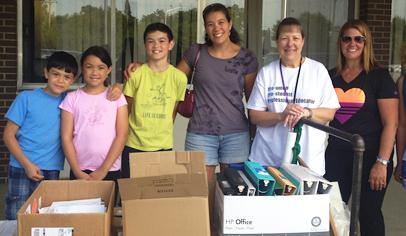Perhaps you’ve had some success finding volunteers; some new parents have offered to help serve coffee at the welcome breakfast or sell raffle tickets at the fall fundraiser. But why does it feel like with each new activity or event, you’re starting all over, looking for new recruits to help out?
Wouldn’t it be great if you had a team of loyal, dependable parents you could count on not only to help out at each event but maybe even to take over planning and running the programs, too? It’s possible. With these simple strategies, you can convert one-time helpers into long-term volunteers.
Have a plan
Kristi Kovalak, a member of the parent group at Reed Elementary in St. Louis, says it takes time and planning to develop a solid team of volunteers. “The key word is ‘cultivate,’” she says. “Recognize that it takes time, and find a volunteer who has the time to source new folks and find out their interests and skills.” This person should be dedicated to getting to know the parents at your school and finding out their unique interests, time commitments, passions, and skills. By tailoring tasks to individuals’ experience and interests, you’re more likely to keep those volunteers engaged beyond a single assignment.
Get organized
In order to leverage parents’ talents and skill sets, you need to plan your volunteer assignments. Too many times boards ask for help at the last minute, limiting the size of the volunteer pool. For an upcoming event, even if the venue is booked, the entertainment’s been hired, and the food is ordered, nailing down the volunteer schedule is critical. Parents who work or care for elderly family members, for example, need notice to clear their schedules. Advance planning also helps you figure out what specific tasks have to get done (and the skills required), how many volunteers are needed, and how and when the work can be completed. Also, know who’s volunteered in the past and keep track of what they did and when they did it. Says Kovalak, “For anyone who has volunteered, find another job for them within three to four months. At least ask; otherwise they disengage.”
Be specific and personal
Too often, boards send out generic requests. A busy parent is more likely to respond to a finite and specific task, such as updating the website or helping with cleanup or sorting box tops, than to a notice that says “Volunteers Needed.” When you are clear about what exactly you need from your volunteer base, you can make specific requests of the parents at your school. A personal appeal is more effective than a call for volunteers on a flyer sent home in a backpack. If you know a parent works the overnight shift, ask her to help with an event during school hours, not with the Halloween dance. If you’re building a new playground, enlist the help of parents who are landscapers or carpenters. When those parents can make a meaningful contribution, they’re more likely to return and do it again.
Provide context
David Bakke, editor of the personal finance site Money Crashers and a PTO father at the Montessori School of Cumming (Ga.), says volunteers seek meaning in the work they do. “One way to turn new PTO volunteers into long-term regulars is to make sure your organization has a vision and long-term goals. Parents are likely to get more involved if they see that the PTO has a plan and goals in place,” he says. For example, if you’re selling gift wrap to fund an arts and enrichment program, let parents know—it’s much more fulfilling to sort order forms when you know the money raised will go toward music lessons. Sarah Barrett, a parent volunteer at Carpenter Community Charter in Studio City, Calif., and author of A Mom’s Guide to School Fundraising, says, “There’s no sense in volunteering if you don’t feel like you’re making a difference.”
Create a timeline
Know that cultivating committed volunteers doesn’t happen overnight. Kovalak says she grows her volunteer program by grade. “Start with the parents in the 1st grade so you have time,” she says. “Assume they are willing but overwhelmed, and take the time to make the first interaction doable and manageable and possibly related to what you think you’ll need longer term. In other words, make it small but measurable.” For example, ask a first-time parent volunteer to contribute to, not publish, the PTO newsletter. Once she has been involved for a while, then you can ask her to take over as editor. This approach will keep parents from getting overwhelmed with requests from your board—something that might drive them away from taking future volunteer assignments.
Be patient
Just as it takes time to grow a garden, it takes time to build a strong volunteer base. Many PTO boards make the mistake of trying to go from planting the seed to yielding the harvest in too short a time frame. Monica Linari, who volunteers with the PTO at the Early Childhood Education Center in Dedham, Mass., says parents avoid PTO meetings so they won’t be asked to do too much. “Many people are worried that if they show up, they are going to be asked to spearhead fundraisers,” Linari says. When someone raises a hand to help or suggests a new way of doing things, don’t pounce. Find out how much that person is willing to do and be grateful for the contribution, no matter how large or small. Make the experience positive and then ask for a little bit more from that person the next time you need help.
Say thanks
If you want parents to volunteer a second time, show your appreciation. This is a simple but critical step in cultivating your team. Taking the time to say thanks can motivate volunteers to do even more great work for your school. Just as important, refrain from showing displeasure at tasks not done to your exact liking. For example, if a volunteer’s very thorough cleanup efforts hold you up from going home after an event, be sure to keep any impatience in check and simply thank her for a job well done. Most volunteers aren’t looking for public recognition, but they do need to know that their efforts matter. “I think appreciation is probably one of the most important aspects of cultivating volunteers. Having a positive experience with a volunteer situation makes a huge difference,” Barrett says.
Avoid burnout
It has happened to all of us: We get an eager new volunteer, so we give her more and more to do. And then all of a sudden, she stops coming to meetings, she avoids our calls, or her calendar books up—forever. It’s a classic case of volunteer burnout, but it can be avoided. Kovalak says most burnout is either self-induced or the result of a bad experience. She layers her volunteers who work on the major activities each year. “We have two cochairs for each event initiative and the committee itself. It helps catch the burnout factor earlier rather than later,” she says.
Also, it may seem counterintuitive, but reducing a regular volunteer’s commitments can be a smart long-term strategy. “Keep an eye out for overcommitted volunteers and scale back their duties,” Bakke says. “Also, when delegating new assignments or responsibilities, make it clear to your volunteer staff that they do have the ability to decline.”
Remember, people volunteer for a reason: “You want to be able to make a difference,” Barrett says. Keep that in mind and they’ll keep coming back.
Originally posted in 2013 and updated regularly.

























